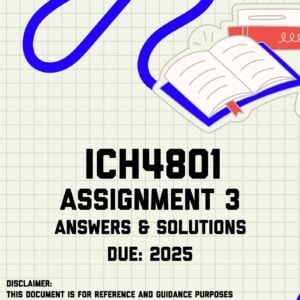Description
NST1501 Assignment 3 Memo | Due 4 August 2025. QUESTION 1
Answer the following questions by selecting only the correct option and writing the letter ONLY.
1.1 What is the primary purpose of animal shelters?
A) For decoration
B) To keep animals safe
C) To entertain humans
D) To train animals
1.2 Which of the following is NOT a type of natural animal shelter?
A) Holes
B) Caves
C) Kennels
D) Nests
1.3 What is burrowing, as mentioned in the context of animal shelters?
A) Building a nest
B) Climbing trees
C) Digging underground tunnels
D) Making a cage
1.4 Which of the following animals is known to live in a cave?
A) Birds
B) Meerkats
C) Bears
D) Koalas
4
1.5 What material is primarily dissolved to form solutional caves?
A) Granite
B) Limestone
C) Sandstone
D) Marble
1.6 Which of the following is a human-made structure for animals?
A) Trees
B) Caves
C) Stables
D) Shells
1.7 What is a characteristic feature of a bird cage as described in the content?
A) It is made of mud.
B) It has many open spaces.
C) It is underground.
D) It is shaped like a tree.
1.8 Why are poles in a kraal placed close to one another?
A) To decorate the kraal
B) To prevent cows from escaping
C) To provide shade
D) To allow ventilation
1.9 Which type of animal shelter is designed to accommodate horses?
A) Kennels
B) Stables
C) Cages
D) Trees
NST1501/101
5
1.10 Why do some animals prefer to live in trees according to the content?
A) For better ventilation
B) To avoid predators
C) To be closer to the ground
D) To store food
[10]
QUESTION 2
Identify whether the following statements are true or false.
2.1 A greenhouse is a frame used to protect plants from extreme weather conditions.
2.2 Endoskeletons are internal skeletons found in invertebrates.
2.3 A shell structure is used to protect organisms by enclosing them inside a rigid, outer layer.
2.4 The rib cage is considered a frame structure that protects the internal organs, such as the heart.
2.5 Tubing refers to bending materials to create a solid shape for better support and balance.
[10]
QUESTION 3
Answer the following questions.
3.1 Define raw materials and give two examples. (2)
3.2 What is the difference between natural materials and raw materials? (2)
3.3 What are processed materials? Give one example. (2)
3.4 Identify the raw material used to make the following: a clay pot. (1)
3.5 Explain why processed materials are useful. (2)
6
3.6 What is food processing? (2)
3.7 Name two methods of food processing mentioned in the text. (2)
3.8 Give one advantage and one disadvantage of food processing. (2)
3.9 Differentiate between minimally processed and highly processed foods. (2)
3.10 Name one potential health risk of consuming highly processed foods. (1)
3.11 Why is it important to process food before transportation? (2)
[20]
QUESTION 4
Answer the following questions:
4.1 Explain why water purification is important for both humans and animals. (3)
4.2 Describe the five main steps involved in the water purification process. (5)
4.3 Compare and contrast the processes of coagulation and flocculation in water purification. (3)
4.4 Discuss the role of filtration in the water purification process and explain how it differs from sedimentation. (3)
4.5 Explain the potential health risks associated with consuming water that has not been properly purified. Provide two examples of such health risks. (3)
4.6 Evaluate the importance of disinfecting water as the final step in the water purification process. (3)
[20]
QUESTION 5
Provide answers to the following questions:
5.1 Explain two key benefits of digitalisation in education, providing specific
examples. (4)
NST1501/101
7
5.2 Identify and briefly explain two characteristics of digitalisation in
education. (4)
5.3 Discuss two challenges that might arise from the integration of digital technologies in education. (4)
5.4 Explain how artificial intelligence (AI) can be utilised to enhance teaching and learning. (4)
5.5 Describe how virtual reality (VR) and augmented reality (AR) can be applied in a science classroom to enhance the learning experience. Provide one example for each technology. (4)
[20]












Reviews
There are no reviews yet.